
Different Types of Commercial Juicers
Choosing the Right Commercial Juicer
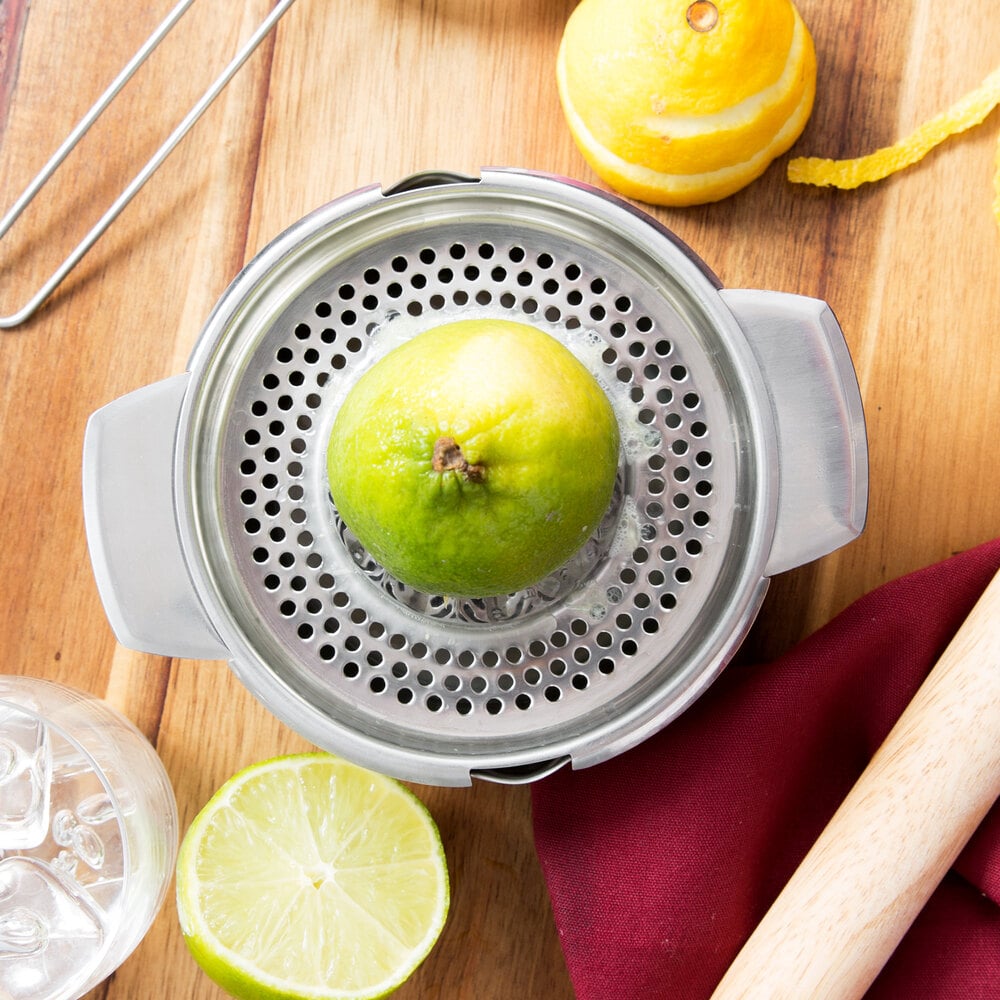
When you are looking for a commercial juicer, there are two big questions you need to ask.
What Are You Juicing?
Not all juicers are created equal. Different types of juicers are ideal for juicing different types of fruits and vegetables.
If you only want to juice citrus fruits, then a manual or electric citrus juicer is a great choice for you. If you want to juice herbs or wheatgrass, you will want to go with a wheatgrass juicer.
How Much Are You Juicing?
The amount of juice you want to produce is an essential factor in picking the right juicer for your application. If you only want to squeeze some fresh lemon juice for cocktails, then a manual juicer might be just the thing for you. On the other hand, if you want to bottle juice for sale, you will want an electric commercial juicer that can handle a high volume and demand.
Types of Juicers
Below we'll breakdown 9 juicer types so you choose the one that best matches your business's needs and goals. What type of juicer is best for your business will mostly depend on the volume of juice your business is looking to offer as well as the type of foods you're looking to juice.

1. Centrifugal Juicer
Application: Medium- to high-volume use in juice bars, spas, restaurants, or cafes
Used for: Apples, Oranges, Celery, Limes, Lemons, Tomatoes, and other hard or firm fruits and vegetables with thick peels, large seeds, and stems removed
How to Use: Centrifugal juice extractors use a spinning metal mesh basket to pulp fresh foods and remove juice. Prepare fruits by removing thick skins, large seeds or pits, and stems, and cutting down to size. Turn on the juicer and allow it to reach full speed. Slowly add fruit and vegetables.
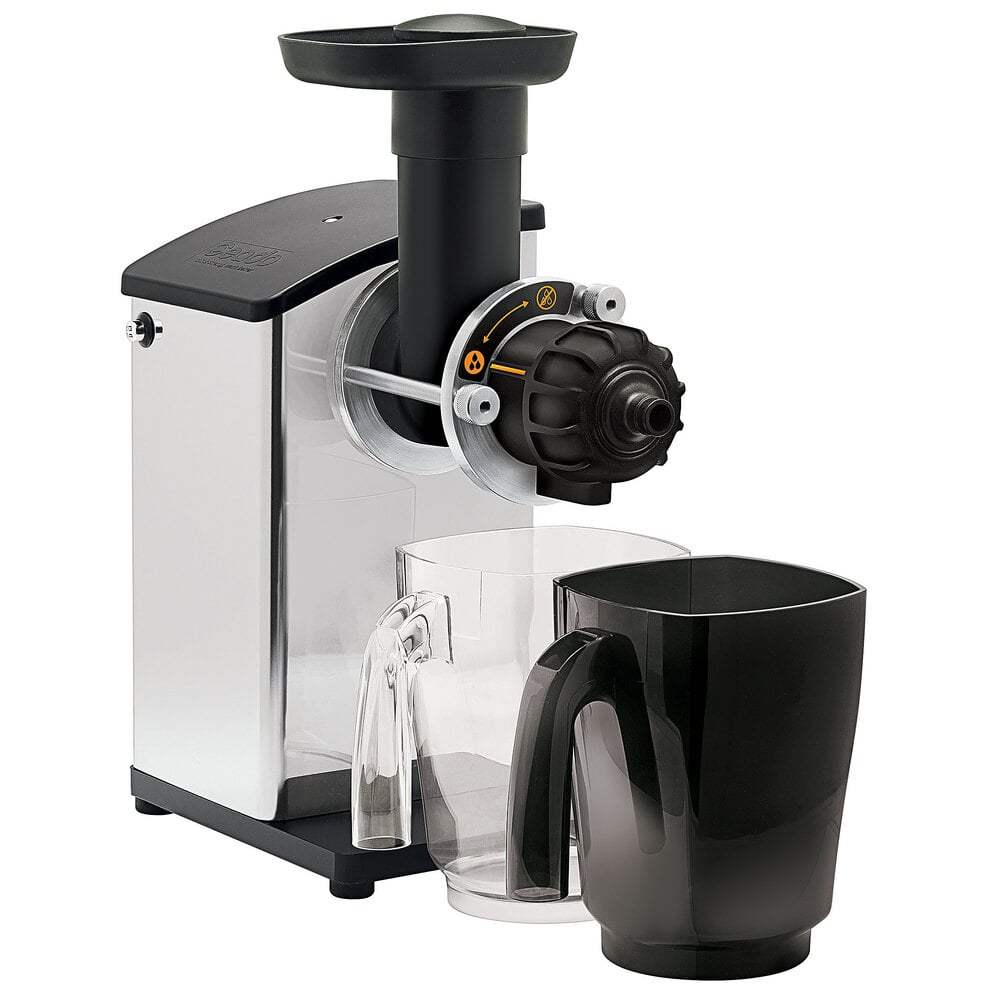
2. Masticating Juicer
Application: Medium- to high-volume use in juice bars, spas, restaurants, or cafes
Used for: Spinach, Kale, Apples, Oranges, Celery, Limes, Lemons, Tomatoes, and other hard or soft fruits and vegetables with thick peels, large seeds, and stems removed
How to Use: Masticating or cold press juicers use an auger and strainer to remove juice from even tough greens. Prepare room temperature fruit and vegetables by removing peels, stems, and seeds, and cutting in half. Turn unit on. Slowly add foods to the chute. If needed, press down with the provided pusher.
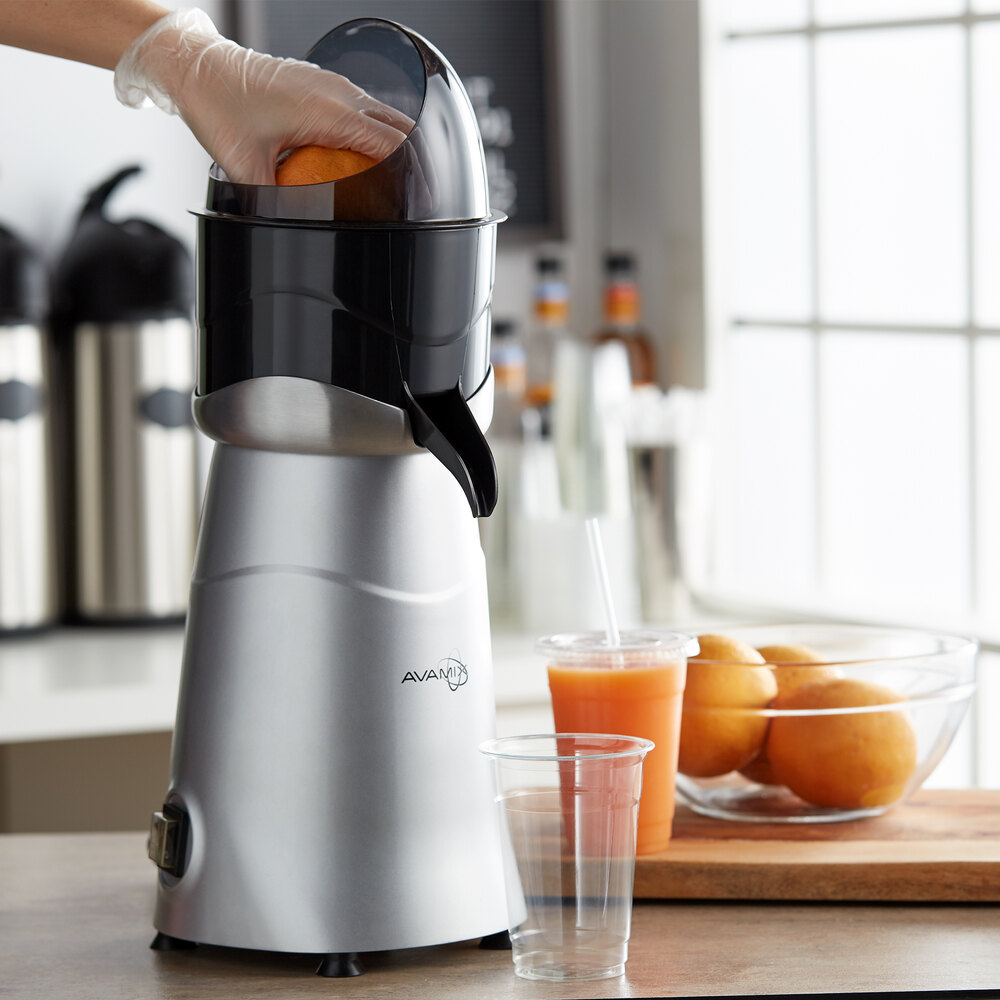
3. Citrus Juicer
Application: Medium-volume use in bars, restaurants, and concessions
Used for: Lemons, Limes, Oranges
How to Use: Citrus juice extractors use a motorized spinning reamer to remove juice from citrus. To begin, halve and prepare the fruit. Turn on the machine. Press the cut side of the fruit firmly downward against the reamer, but not so hard that the reamer stops.
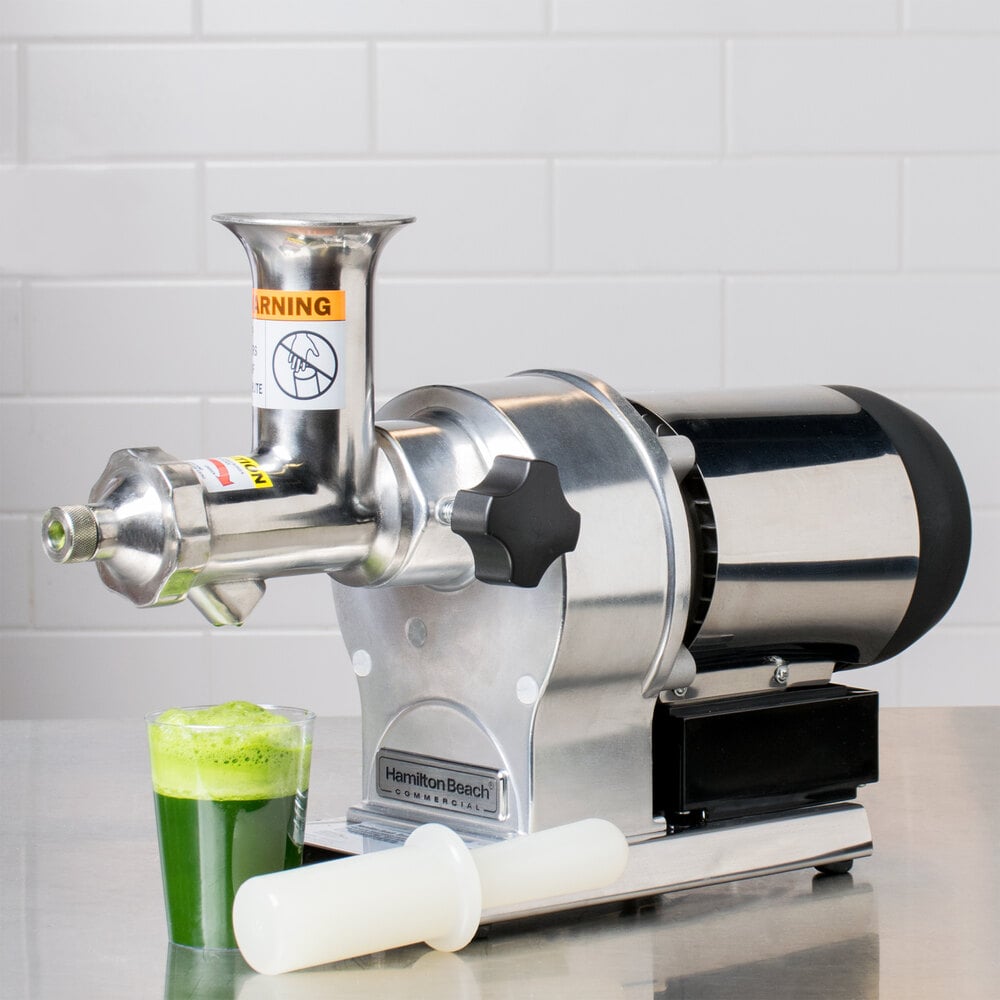
4. Wheatgrass Juicers
Application: Medium- to high-volume use in juice bars, spas, restaurants, or cafes
Used for: Grasses, Sprouts, Herbs, Leafy Greens; not for use with fruit
How to Use: Cut grasses above the roots. Remove woody stems if present. Turn the wheatgrass juicer on. Feed grasses or greens through the chute. Use the provided pusher to help feed the product into the machine.
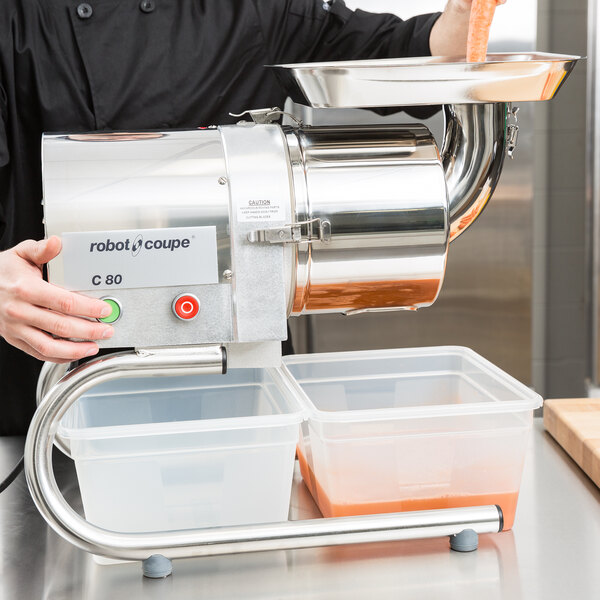
5. Sieve
Application: Medium- to high-volume use in restaurants, bakeries, or hotels
Used for: Cut fruits, whole berries, chopped olives, pre-cooked vegetables, sauces, bisques, ground fish
How to Use: Sieves use a strainer to separate seeds and skins from juice. Before beginning, be sure to follow the manufacturer’s instructions to prepare foods for processing. Load the product tray. Turn the unit on. Slowly feed product into the feed chute.

6. Orange Juice Machine
Application: Medium- to high-volume use in markets, spas, hotels, restaurants, or cafes
Used for: Oranges
How to Use: Ensure the machine is set up for operation. Add fruit to the feeding chute. Orange juice machines may vary, but in general simply press the lever to begin squeezing and press the stop button to stop squeezing.
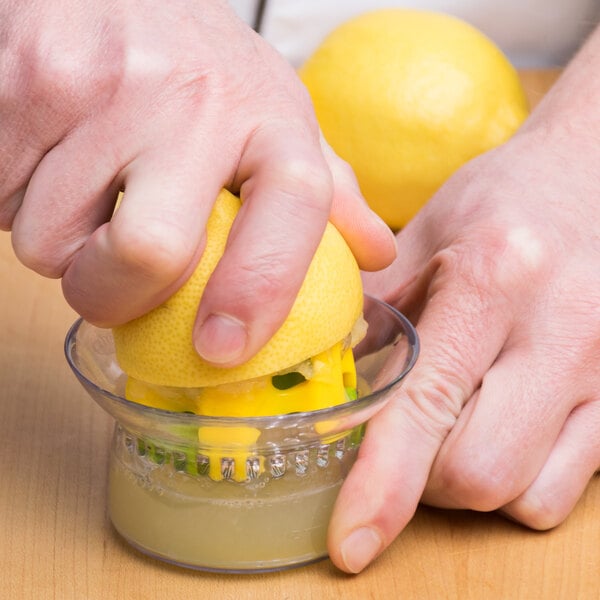
7. Reamer
Application: Low-volume, infrequent use in bars or cafes
Used for: Lemons, Limes, Oranges, Grapefruit
How to Use: Halve the fruit. Press the reamer into the cut side of the fruit and twist firmly to release juice.

8. Citrus Squeezer
Application: Low-volume, infrequent use in bars, bakeries, or cafes
Used for: Lemons, Limes, Oranges
How to Use: Halve the fruit. For maximum efficiency, place the fruit in the citus squeezer with the cut side down. Squeeze the handles together to invert the peel and extract the juice.
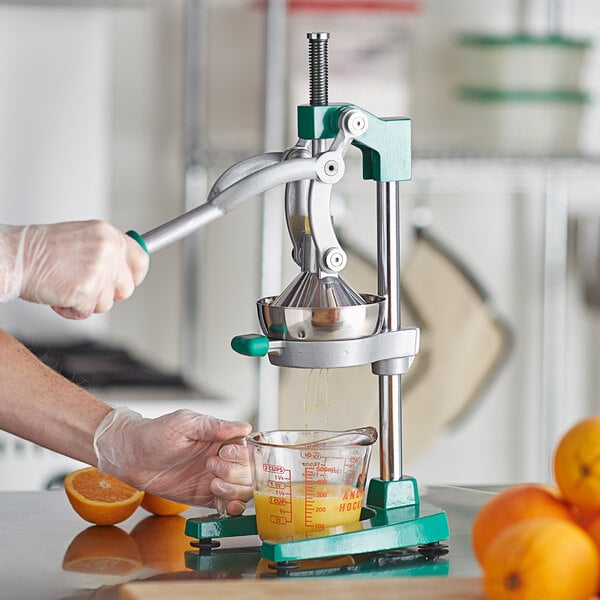
9. Hand Press Juicer
Application: Low- to medium-volume use in bars, cafes, or concessions
Used for: Lemons, Limes, Oranges
How to Use: Halve the fruit. Place the cut side of the fruit down on the manual juicer. Pull down on the juicer’s handle to close the press and extract the juice.
Benefits of Fresh Juice
There is no doubt that fresh-squeezed juice is full of healthy vitamins and nutrients. And offering this option to customers at your health club, spa, restaurant, or hotel can be pretty healthy for your bottom line, too!
How Juice Can Grow Your Business

If you are looking for a profitable way to expand your menu, adding fresh juices may be the way to go.
- Reduce Waste: If produce is overripe and past its prime for serving whole, you may be able to use it in juices and smoothies rather than throwing it out.
- Big Profits: Fresh juice products can have high profit margins and minimal overhead.
- All Day Sales: Juice can be paired with breakfast orders, sold after mid-day workouts and spa treatments, or stirred into specialty cocktails at night.
- On Trend: Fresh juices are popular and trendy, plus you can cash in on consumers' growing desire to eat healthy.
- A Healthy Option: Cater to a wider customer base by providing health-conscious customers with an option that fits their lifestyle.
- Switch it Up: Seasonal juices made using local ingredients can show a commitment to your community while drawing customers back to see what's new, all year long.
The Health Benefits of Juicing

Juice contains many beneficial nutrients and it can be a great way to add more variety of fruits and vegetables to the diet. For customers who are looking for that benefit, or just want a healthy and refreshing alternative to sugary sodas or coffee drinks, fresh juice is a delicious option. Many types of juice (like wheatgrass) are also great for adding boosts of energy and nutrients to smoothies and drinks!
One thing to keep in mind is that health experts don't recommend using juice as a meal replacement. Also, eating fruits and veggies whole will still give you the most benefit. Many types of juice just don't contain the same amount of fiber and certain other nutrients as their whole food counterparts.
So, is fresh-squeezed juice good for you? The short answer is, yes! But remember that there is more to the story.
Juicing Safety and Regulations

Creating homemade juices can be a healthy and profitable addition to your menu - or a great business on its own! But keep in mind that there are some special considerations when selling, bottling, or distributing fresh juice.
Juicing Regulations and Licensing
Many municipalities and health departments have special requirements for juicing operations. Be sure to check with your city and state regulatory agencies before starting your juice operation.
HACCP Guidelines
Because juice is prepared from fresh foods and is often not processed further, it is especially important to ensure that fruits and vegetables are clean, follow food safety guidelines, and have documentation procedures in place.
A HACCP plan is a great way to ensure safety in any food operation. It is highly recommended for juice-making operations and sometimes even required if you will be selling your product off site. Be sure to check all the necessary regulatory codes to see if you are required to have a HACCP plan.
Using Juicers Safely
Commercial juicing equipment has moving parts that break down fruits, vegetables, greens, or herbs to remove the juice from the solids. Because of this, you will want to follow a few simple safety guidelines.
- Read the manufacturer's instructions for use of your unit to ensure safe operation.
- Ensure that all staff members who will be using the equipment are properly trained.
- Never push food through a juicer using your hands or cooking utensils. Use only the provided pusher.
- Be sure food is properly prepared before placing it in the juicer. Depending on the type of produce used and the type of juicer, large seeds, stems, and thick peels should be removed. You may also need to cut up large items.
Keeping Juice Extractors Clean
To make sure your juice production equipment is always ready to use, it is important to clean the units right away after they have been used. Waiting to clean a juicer allows residual juice and pulp to dry in the machine, making it difficult to clean later. Many types of fruit juice are quite acidic, too, so cleaning your unit right away will help reduce corrosion.
Related Resources

How Much Juice Is in Citrus Fruits
If you're using a recipe that calls for a certain amount of fresh citrus juice, you may be wondering how many fruits you actually need. The number could depend on the individual fruit, because some are more or less juicy than others. The amount of juice in a single citrus fruit may vary depending on where you're purchasing it and the season you're in . That being said, there are some general numbers we can use for how much juice is in a single lemon, lime, orange, grapefruit, or other citrus fruit. Shop All Manual Juicers Click below to learn about fresh juice conversions: Juice in One Lemon Juice in One Lime Juice in One Orange Juice in One Grapefruit How Much Juice in One Lemon? On average, there are 3 tablespoons of juice in one lemon. S
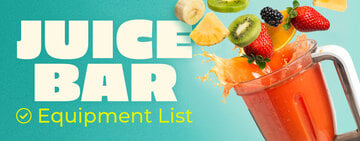
Juice Bar Equipment List
Juice bars have become increasingly popular as people become more health-conscious and seek nutritious alternatives to sugary drinks. Whether you plan on starting a new juice bar or want to expand your existing one, you need different equipment to make and serve delicious and nutritious drinks. This juice bar equipment list outlines the essential equipment and supplies you need to operate your juice bar or smoothie shop ranging from blenders and juicers to cups and straws. Shop All Juice Bar Equipment and Smoothie Supplies Use the following links to learn more about juice bar equipment: Smoothie Equipment Smoothie Ingredients Serveware Cooking Equipment Food Prep Equipment Compartment Sink Refrigeration and Storage Miscellaneous Smoothie Su

Tropical Fruits List
If you own a restaurant, you're probably curious about different ingredients from around the world, and how you can utilize all of them in new, exciting recipes. If you own a juice or smoothie bar , chances are you need to learn how to use a variety of fruits for your menu. Below is a list of tropical fruits so you can bring a bit of the sunny tropics to your menu easily and deliciously. Before starting, make sure all of your fruits are properly washed to keep your customers safe. Use these links to learn more about specific tropical fruits: Dragon Fruit Passion Fruit Rambutan Acai Jackfruit Mangosteen Lychee Papaya Guava List of Tropical Fruits Many common tropical fruits are native to the countries that lie along the Earth's equator. Belo
- Topics 1356
- Industrial 55
- Troubleshooting Guides 21
- Restaurant Management 128
- Bar Management 56
- Catering Tips 36
- Bakery Management 42
- Food Trucks & Concessions 49
- Advertising & Marketing 37
- Eco-Friendly Tips 11
- Facility Layout & Design 42
- Coffee Shop Tips 28
- Installation & Maintenance 51
- Janitorial & Pest Control 30
- Safety & Sanitation 88
- Startup Tips 104
- Menu Design 10
- Kitchen & Cooking Tips 83
- Hospitality Management 24
- Pizza & Sandwich Shop Tips 36
- Smallwares 37
- Food Prep 89
- Tabletop Items 17
- Disposables 22
- Calculators & Tools 6
- Consumables 52
- Warewashing & Laundry 19
- Cooking Equipment 91
- Food Storage & Refrigeration 51
- Beverage Equipment 35
- Office Supplies 6
- Resource Type
- In-Depth Articles272
- Buying Guides298
- How-Tos95
- Product Reviews78


